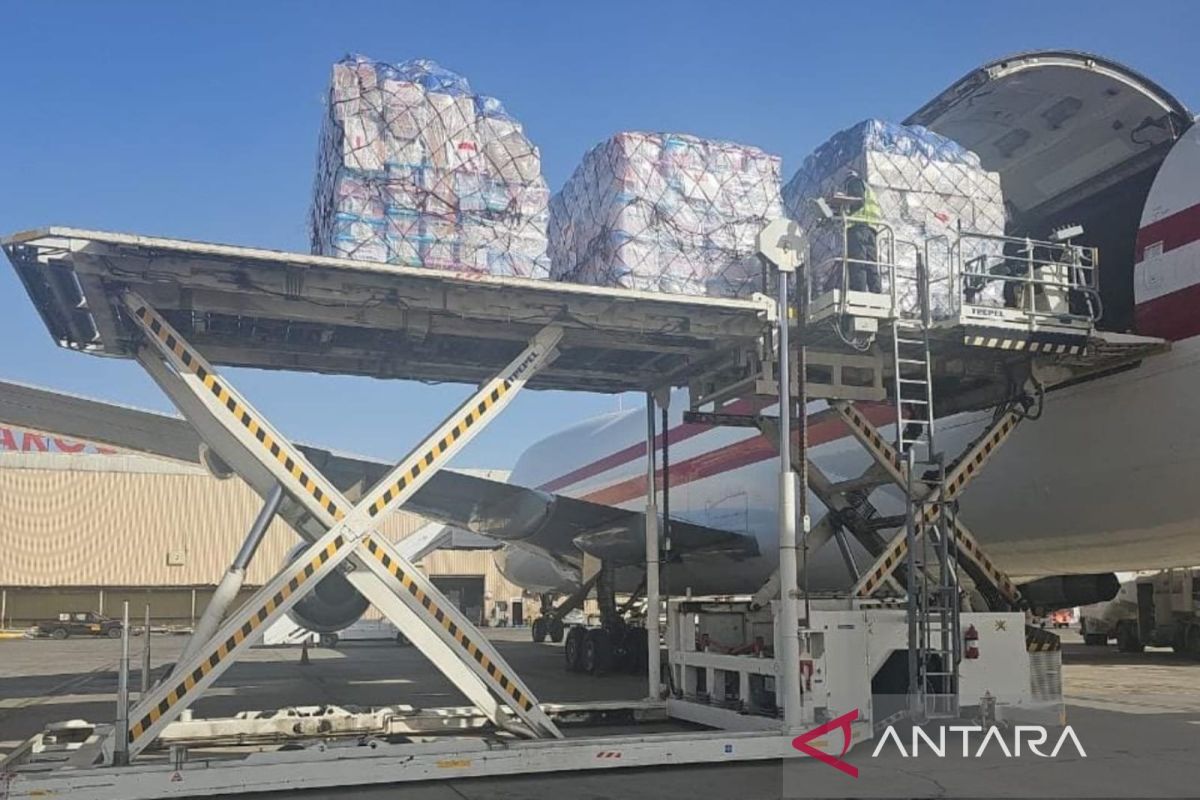Hundreds – possibly thousands – of miners remain trapped in an abandoned gold mine in South Africa’s northwestern Stilfontein town, fearful to come out of hiding and face arrest by security officials in a tense standoff that has continued for weeks.
South African police have guarded the site’s entrance since early November. Officials cut off food and water supplies earlier to force the miners out and vowed they would not assist with rescue operations. Police also say some of the miners could be armed, and that would pose a risk to officials rescuing them.
Illegal mining is a widespread crime in South Africa. Authorities have increasingly taken a hard line, cracking down on miners, called “zama zamas”.
At least one of the miners has been confirmed dead, and several others are believed to be too sick to be rescued.
Here’s what we know about the miners and how the situation came about:
 An aerial view of a closed mine shaft where miners are trapped inside is pictured in Stilfontein, South Africa, November 13, 2024 [AP Photo]
An aerial view of a closed mine shaft where miners are trapped inside is pictured in Stilfontein, South Africa, November 13, 2024 [AP Photo]What happened to the Stilfontein miners?
Police officers first surrounded the entrance to the old gold shaft, which is nearly 2.5 kilometers (1.5 miles) deep, about two weeks ago, aiming to force miners to come out and then arrest them.
It’s part of an official policy called Operation Vala Umgodi, or “plug the hole,” to combat illegal mining. Similar raids are targeting several mines across the country.
Officials at the Stilfontein site at first prevented food or water from being lowered into the mine for several days and also prevented emergency workers from accessing the trapped miners.
That likely contributed to many becoming hungry and weakened. Miners usually go underground for months at a time and depend on community shops or spazas outside the shaft to periodically lower supplies.
What did the courts say?
After activists brought a case before the Pretoria High Court last week, a judge ordered on Saturday that the miners be given supplies, and that the police stop blocking exits. The court also said emergency operations should be allowed. Volunteers said they immediately lowered supplies following the judgement.
On Sunday, police spokesperson Athlenda Mathe confirmed to reporters that officials had allowed supplies to enter the mine, but that the police would remain in the area – likely to arrest any resurfacing miners.
“We are not blocking anyone from resurfacing … our responsibility here is to combat any illegal activities. We have allowed food and water to go down so that they can regain their strength and resurface,” Mathe said.
She maintained that officials would not enter the shaft to assist miners, as the miners may be armed. She also said the shaft was very deep and could have toxic gasses flowing through it.
Earlier on Wednesday, South Africa’s Minister in the Presidency Khumbudzo Ntshavheni drew anger and protests from families of the miners when she said authorities wanted to “smoke them out”.
“They will come out. We are not sending help to criminals. Criminals are not to be helped – they are to be persecuted [sic],” the minister said.
South Africa’s President Cyril Ramaphosa said on Monday that lives should not be put at risk amid the standoff between police and miners stuck underground.
“The police will carry out their duties and responsibilities to bring the illegal miners to the surface safely,” he said.
 Relatives and friends protest near a gold mine shaft where illegal miners are trapped in Stilfontein, South Africa, November 15, 2024 [Denis Farrell/AP Photo]
Relatives and friends protest near a gold mine shaft where illegal miners are trapped in Stilfontein, South Africa, November 15, 2024 [Denis Farrell/AP Photo]How many miners are in the Stilfontein shaft, and what are the conditions?
Officials say there are between 350 and 400 miners, although community members, as well as some miners who have been hauled up, say up to 4,000 people are trapped.
Hunger appears to be the biggest problem since authorities earlier prevented food from entering the shaft. Many miners are believed to be starving, and some are reportedly eating toothpaste and vinegar.
“There’s nothing left for someone to eat, to drink, or anything that can make a human being survive. There is nothing left underground for now,” Ayanda Ndabeni, 35, who was earlier hoisted out of the shaft on Friday by volunteers, told reporters later on Sunday.
Miners on Saturday sent up a note asking for antiretroviral medication, which is crucial for persons living with HIV.
Illegal miners face a fine or up to six months in prison. If they are undocumented migrants, they face deportation. Migrants from neighbouring countries like Lesotho and Mozambique make up a significant population of illegal miners in South Africa.
How are the Stilfontein miners being rescued?
Rescue operations by dozens of community volunteers are under way using old ropes.
There are around 50 volunteers, mostly men. Volunteers say they have to manually pull people up at an extremely slow pace. Since Saturday, three people have been rescued alive. An official rescue operation would likely make the process much faster.
“We dip the rope into the hole and we pull up one person at a time,” Thabang Morulane, one of the volunteers at the site, told Al Jazeera’s Malcolm Webb on Monday. “We are not getting any help from the authorities … They just come to check if those people are not carrying anything which is illegal … or minerals they have been mining.”
Morulane said the men are pulling out an average of one to two people daily. Volunteers are worried the ropes could cut midway. Those hoisted up look visibly frail and dehydrated.
“When they come out, they are in a devastating condition,” Morulane added. “You can see they have spent a very long time without eating. It’s not easy pulling them to the surface, it’s very tedious. We need more manpower,” he said.
Some of those hoisted up have been arrested, while one person needing medical care was transported to a hospital.
Volunteers have pulled up at least one body, although it’s not clear how the person died. There are likely more dead miners, according to the rescuers.
 Police officers and private security personnel stand by the opening of a gold mine shaft where miners are trapped in Stilfontein, South Africa, November 15, 2024 [Denis Farrell/AP Photo]
Police officers and private security personnel stand by the opening of a gold mine shaft where miners are trapped in Stilfontein, South Africa, November 15, 2024 [Denis Farrell/AP Photo]How widespread is illegal mining in South Africa? What is shaft mining?
Illegal mining for gold, diamonds or other minerals is deeply widespread in South Africa, and has gone on for decades, with about 30,000 people involved by 2019.
Driven largely by poverty, the practice leads to about $1bn in annual losses for South Africa, according to government figures, and contributes to the country being one of the biggest sources of illicit gold in Africa.
South Africa was once an industrial mineral mining giant that employed thousands of people from neighbouring countries. However, the economy shrunk in the 1970s due to declining gold reserves. Many shaft mines were abandoned, and many employees were laid off.
Zama zamas mostly operate in some 6,000 disused mines, looking for leftover gold ore. Mining companies back then used the old shaft mining process that involved digging vertical tunnels deep underground and blasting off rocks to reach gold veins.
Illegal miners go into these old, often unstable shafts, and use basic materials like picks and buckets to scoop gold ore. The gold processed is bought by underground dealers and smuggled abroad. It makes up about 10 percent of all mined gold in South Africa.
It’s a violent trade. Many zama zamas are controlled by criminal syndicates who fight one another in gang wars and also attack police and security officers. They’re also increasingly targeting active, legal mining businesses. Often, the mines collapse, killing the people there.
Undocumented migrants make up more than half of illegal miners. Some of them are forced into the trade and exploited by criminal syndicates that make them pay debts they were not aware of. Officials estimate that 70 percent of zama zamas are undocumented migrants who are easily transported over porous borders from neighbouring countries like Zimbabwe, Lesotho, and Mozambique.
Communities where abandoned mines are located claim that illegal miners are contributing to rising crime levels, from armed conflict to robberies and sexual assault. Officials also say illegal mining damages infrastructure due to poor mining practices.
An estimated 312 zama zamas died between 2012 and 2015, according to the South African government.
Have there been similar incidents or standoffs between illegal miners and the police?
Yes, police similarly targeted an illegal mine in Orkney, 28km (17 miles) south of Stilfontein, earlier in November.
At least 565 illegal miners were arrested after their food supplies were choked off, officials said on November 3. Shops in the communities that would normally supply the miners were stopped from doing so, forcing many people to emerge. Hundreds are still believed to be in that shaft.
In August, seven illegal miners died and several others were injured after police raided the Daggafontein Mine in Gauteng Province. A fire swept through reeds the miners usually use as an escape route. The miners accuse the police of setting the fire, but officials have denied responsibility.
Speaking to Al Jazeera, Sifiso Dladla of Action Aid Africa faults the government’s approach of criminalising the trade, pointing out that a police-led crackdown “is not working”.
“What is needed in the sector is to decriminalise it, formalise it, and regulate it … Even the artisanal miners are not getting what they should be getting and large-scale mining is losing because they have to extend their security,” Dladla said.
Nearly 14,000 suspects have been arrested across the country since December 2023, when the police intensified crackdowns, according to Deputy National Police Commissioner Shadrack Sibiya. Officials said they seized 5 million South African rans ($277,000) in cash and uncut diamonds worth 32 million rands ($1.8m).

 3 hari yang lalu
3 hari yang lalu




:strip_icc():format(webp)/kly-media-production/medias/4974549/original/054761200_1729489016-Serang_Beirut_Malam_Hari__Israel_Targetkan_Cabang_Keuangan_Hizbullah.jpg)
:strip_icc():format(jpeg)/kly-media-production/medias/4974929/original/059107200_1729512961-WhatsApp_Image_2024-10-21_at_18.07.05.jpeg)

:strip_icc():format(jpeg)/kly-media-production/medias/4971251/original/027865000_1729139289-IMG_20241017_110701.jpg)

 English (US) ·
English (US) ·  Indonesian (ID) ·
Indonesian (ID) ·